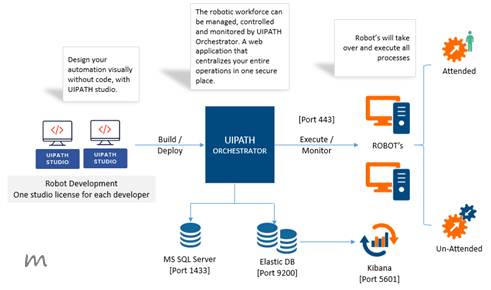RPA: What it is?
Robotic Process Automation is an emerging form of Business Process Automation that mimics what people do by autonomously logging on, capturing data and orchestrating various applications and systems. RPA tools are smart enough now a days that carry out intelligent automation (IA) as against the regular form of rule-based automations when it got introduced.
RPA is termed as a non-invasive automation technique as it does enable automation at the UI Layer interacting across multiple applications by emulating human actions without the necessity of changing the existing applications. These robots put together forms the virtual workforce within the organization and are controlled by the Business Operations team. They interact with any application or system using non-invasive techniques.
Deploying RPA software is not equivalent to building fully automated processes and platforms from the ground up. With standalone RPA, a software robot literally does what a human would do: tasks such as data retrieval and entry, button clicks, file uploads and downloads, or invoice processing.
The UiPath RPA platform has three major components namely, UiPath Orchestrator, Robot and Studio. Orchestrator is the server platform that acts as a control room to manage, monitor and control the entire virtual workforce.
Orchestrator facilitates centralized logging, monitor and control your robots, manage jobs, schedules, queues, assets and also offers role-based user and access management.
In short, Orchestrator is targeted for administration and monitoring of robots. The robot is the UiPath’s execution agent that runs the workflows built using studio. The robot (agent) is installed as a windows service by default or it can
be installed at the user level. However, you can connect the robot to Orchestrator in both the modes. Robots need to be connected to Orchestrator to execute processes or they have to be licensed locally. Robots execute the automation workflow designed in UiPath Studio and can be centrally managed from UiPath Orchestrator. UiPath offers two types of robots namely Attended and Unattended Robots. UiPath studio is the comprehensive integrated development environment (IDE) for the developers to create their automation workflows. The studio looks more like a modelling tool, where it enables you to automate business processes graphically using flowcharts, sequences and state machines. The workflow you create using studio will consists of multiple action steps such as clicking button, typing a text etc. These actions are called as activities and the activities are grouped into packages.
The developers can drag and drop activities to create their workflow. Some of the key benefits of RPA are as follows: Here below are some common myths about RPAUnderstanding UiPath Platform

UiPath Orchestrator
UiPath Robot
UiPath Studio
Benefits of RPA
Myths about RPA
See also